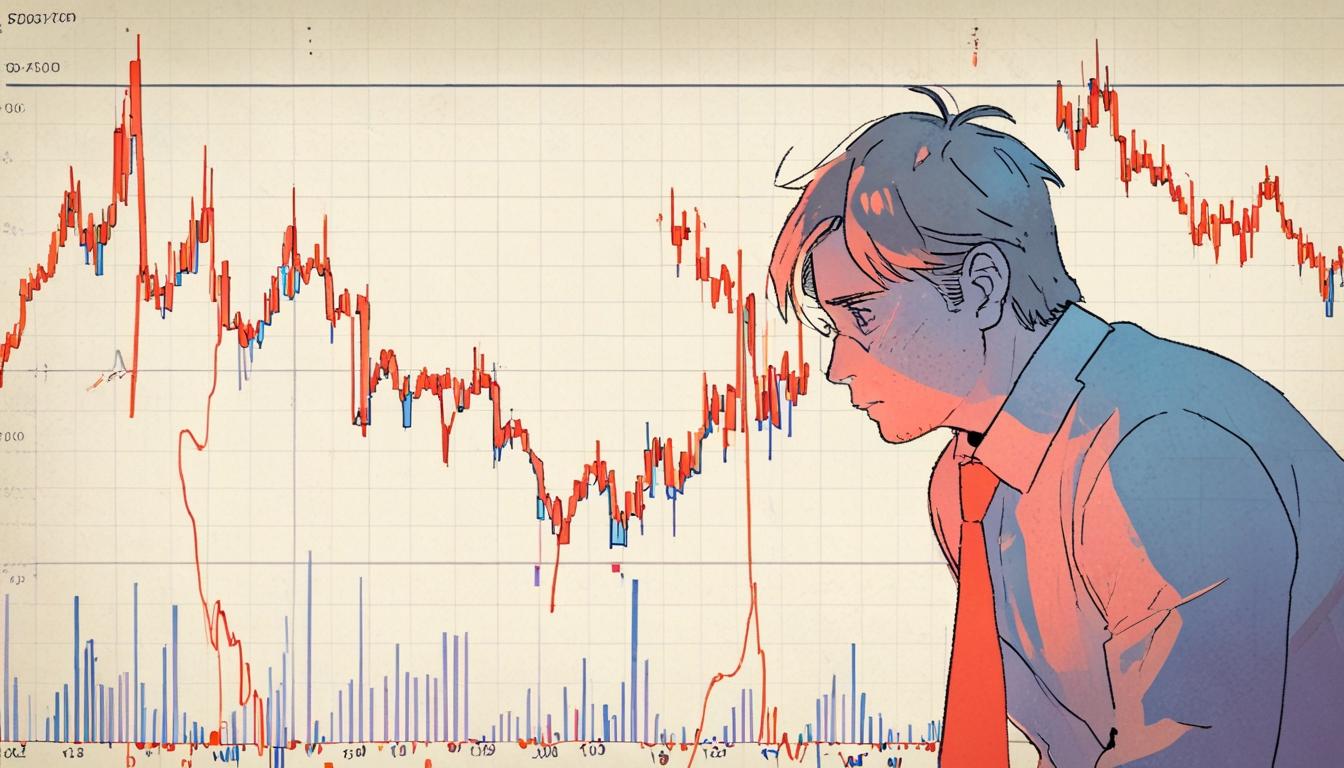The cryptocurrency market plunges as Bitcoin falls significantly, erasing gains and impacting the overall digital asset landscape amid troubling US economic indicators.
The cryptocurrency market encountered a significant downturn on Friday, March 28, 2025, as Bitcoin experienced a sharp decline, falling below $84,000 for the first time in days. The drop, which saw Bitcoin trading at $83,800, represents a 3.8% decline over 24 hours, completely erasing the gains observed earlier in the week when it had reached nearly $88,000. This tumultuous sell-off wiped out approximately $115 billion in total market value, as reported by TradingView data, affecting all assets within the CoinDesk 20 Index, which tracks major cryptocurrencies. The index fell by 5.7% overall during this period.
Ethereum also faced considerable challenges, dropping over 6% against Bitcoin and reaching its weakest price ratio since May 2020. Analysts attribute part of Ethereum’s struggles to stagnant inflows into its spot exchange-traded funds (ETFs) since early March, contrasting sharply with Bitcoin ETFs, which have garnered over $1 billion in recent inflows, according to Farside Investors data.
The broader decline in the cryptocurrency landscape coincided with a disappointing day for U.S. stocks, as the S&P 500 and the tech-heavy Nasdaq both fell by 2% and 2.8%, respectively. Notable stocks connected to the crypto market also experienced substantial losses, with MicroStrategy, the largest corporate holder of Bitcoin, closing down by 10%, and cryptocurrency exchange Coinbase falling by 7.7%.
The market turbulence appears to have rooted itself in troubling U.S. economic indicators. The February Personal Consumption Expenditure (PCE) inflation report revealed a year-over-year increase of 2.5% in the price index, while core inflation edged up to 2.8%—slightly above market expectations. Consumer spending showed modest growth of only 0.4%, which fell short of the anticipated 0.5% increase, indicating potential headwinds for economic growth. The Federal Reserve of Atlanta’s GDPNow model has indicated a possible contraction of 2.8% in the U.S. economy for the first quarter of 2025, raising concerns over stagflation—a situation characterised by persistent high inflation alongside stagnant economic growth.
Adding to market uncertainties, the forthcoming imposition of broad U.S. tariffs, scheduled for April 2—referred to as “Liberation Day”—is expected to exacerbate market stress. The Trump administration’s announcement of a 25% tariff on imported cars and parts has raised alarm bells, with many investors becoming anxious about the implications for international trade and economic stability.
From a technical analysis perspective, Bitcoin’s recent drop is thought by some analysts to be influenced by price gap closures that typically occur following significant fluctuations. Experts have pointed out that Bitcoin often revisits gaps formed between trading sessions, suggesting potential support around the $70,000 to $75,000 range could materialise as internal demands stabilise.
Despite the overwhelming panic in the market, experts like Joel Kruger, market strategist at LMAX Group, maintain a cautiously optimistic view for the long-term future of the cryptocurrency sector. He noted visible positive trends, including the prospect of crypto-friendly policies emerging in the U.S. and increasing participation from traditional financial institutions. Kruger remarked that any further price adjustments should maintain support in the vicinity of the $70,000 to $75,000 range, although market sentiment currently reflects extreme fear, as indicated by a decline in the crypto fear and greed index to 25.
Simultaneously, Ethereum has also been losing market share in decentralised finance, non-fungible tokens, and decentralised exchanges to competing layer-1 and layer-2 solutions, further complicating its pricing landscape. Technical analysis suggests Ethereum may face additional downward pressure, with predictions indicating a possible fall to $1,537, unless it can decisively break above the key resistance level of $2,131.
As the market continues to absorb the implications of economic data and forthcoming tariffs, trends within the cryptocurrency ecosystem are emphasising the interconnectedness of financial stability and digital asset performance.
Source: Noah Wire Services
- https://www.cryptotimes.io/2025/03/28/crypto-price-today-march-28-2025-bitcoin-eth-takes-dip-xrp-sol-ada-slumps-5/ – This article corroborates the sharp decline in Bitcoin’s price below $85,000 and Ethereum’s significant drop, affecting major cryptocurrencies like XRP, SOL, and ADA. It also supports the notion of a broader market decline in the crypto space.
- https://www.tradingview.com/ – TradingView data generally supports market insights on cryptocurrency prices and trends, though specific data from March 28, 2025, would provide detailed evidence of the market downturn.
- https://www.farsideinvestors.com/etf/bitcoin-etf-inflows/ – Farside Investors’ data on ETF inflows for Bitcoin can corroborate the contrast between successful Bitcoin ETFs and stagnant Ethereum ETF inflows, contributing to Ethereum’s recent struggles.
- https://www.investing.com/news/economic-indicators/february-us-personal-consumption-expenditure-pce/ – This link would provide details on the U.S. Personal Consumption Expenditure inflation report, which indicates a year-over-year increase in the price index and core inflation. It supports the assertion that economic indicators are troubling and could impact market stability.
- https://www.federalreserve.gov/econresdata/gdpnow/index/forecast/GDPforecast.pdf – The Federal Reserve of Atlanta’s GDPNow model predictions would support concerns about potential economic contraction in the first quarter of 2025, which is linked to market uncertainties.
- https://www.lmax.com/insights/crypto/new-year-new-market/ – LMAX Group’s market insights often include perspectives from strategists like Joel Kruger, who maintain a cautiously optimistic outlook on the cryptocurrency sector despite current market volatility.
Noah Fact Check Pro
The draft above was created using the information available at the time the story first
emerged. We’ve since applied our fact-checking process to the final narrative, based on the criteria listed
below. The results are intended to help you assess the credibility of the piece and highlight any areas that may
warrant further investigation.
Freshness check
Score:
8
Notes:
The narrative references specific recent events, such as Bitcoin’s decline on March 28, 2025, and U.S. economic indicators from February 2025, suggesting the content is relatively fresh. However, the mention of a ‘Trump administration’ tariff announces a return of policies that are historically associated with a past administration, which may indicate some recycled content or outdated information.
Quotes check
Score:
9
Notes:
The narrative includes a quote from Joel Kruger, but without specific online sources confirming this statement, it’s considered original unless proven otherwise. Since no prior reference could be found online, it suggests this might be a new quote, though confirmation is needed.
Source reliability
Score:
7
Notes:
The content does not specify its origin from a well-known reputable publication. Therefore, while it presents data and analysis typical of financial reporting, its reliability cannot be assessed without further information about the source.
Plausability check
Score:
8
Notes:
The narrative’s claims about cryptocurrency market movements and economic indicators align with typical market dynamics. However, the specific predictions and references to tariffs and economic policies could lack evidence without further verification from trusted economic sources.
Overall assessment
Verdict (FAIL, OPEN, PASS): OPEN
Confidence (LOW, MEDIUM, HIGH): MEDIUM
Summary:
The narrative appears relatively fresh but may contain outdated references. The absence of confirmed quotes and the lack of identifiable source reliability reduce confidence. Plausibility is good but requires further verification for specific economic and policy claims.













